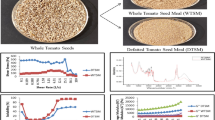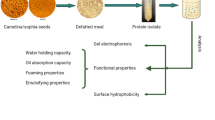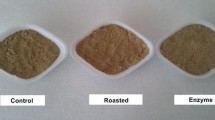Abstract
The seeds separated from tomato pomace may contain valuable protein with unique functional properties. The objectives of this research were to study the impact of industrial hot and cold break tomato processes on protein isolation from defatted tomato seed meal and determine the protein-related functional properties of defatted and non-defatted seed meals. The results showed that the high temperature of hot break process denatured the protein, resulting in the lower protein extraction yield from 9.07 % to 26.29 % for defatted hot break tomato seed (DHTS) compared to from 25.60 % to 32.56 % for defatted cold break tomato seed (DCTS) under various extraction conditions. Hot break process also significantly influenced protein-related functional properties of seed meals. Compared to DCTS, DHTS had higher water absorption capacity (WAC) and oil absorption capacity (OAC) based on the protein weight in the seed meal, but lower emulsifying ability (EA), emulsifying stability (ES), foaming capacity (FC), and foaming stability (FS) based on the whole seed sample weight. When compared to commercial soybean protein isolate (SP), the meals of hot break tomato seed (HTS), DHTS, and DCTS showed higher bulk density and WAC values. The FC and FS of tomato meals were inferior while the ES was superior to SP. High alkaline pH was beneficial to the protein extraction and achieved better EA, ES, FC and FS of all the samples. The results indicated that tomato seed meals have a great potential to be used as functional food ingredients.


Similar content being viewed by others
References
Ahenkora, K., Dadzie, M., & Osei-Bonsu, P. (1999). Composition and functional properties of raw and heat processed velvet bean (Mucuna pruriens (L.) DC. var utilis) flours. International Journal of Food Science and Technology, 34(2), 131–135.
AOAC. (1990). Official method of analysis (15th ed.). Washington: Association of Official Analytical Chemists.
Barbut, S. (1999). Determining water and fat holding. In G. M. Hall (Ed.), Methods of testing protein functionality (Blackie Academic and Professional, pp. 186–225). New York: USA.
Boye, J., Zare, F., & Pletch, A. (2010). Pulse proteins: processing, characterization, functional properties and applications in food and feed. Food Research International, 43(2), 414–431.
Campbell, N. F., Shih, F. F., & Marshall, W. E. (1992). Enzymic phosphorylation of soy protein isolate for improved functional properties. Journal of Agricultural and Food Chemistry, 40(3), 403–406.
Cantarelli, P., Regitano-d'Arce, M., & Palma, E. (1993). Physicochemical characteristics and fatty acid composition of tomato seed oils from processing wastes. Scientia Agricola, 50(1), 117–120.
Chandi, G. K., & Sogi, D. (2007). Functional properties of rice bran protein concentrates. Journal of Food Engineering, 79(2), 592–597.
Chau, C., & Cheung, P. (1998). Functional properties of flours prepared from three Chinese indigenous legume seeds. Food Chemistry, 61(4), 429–433.
Damodaran, S. (1997). Food proteins: an overview. New York: Marcel Dekker.
Del Valle, M., Cámara, M., & Torija, M. (2003). Effect of pomace addition on tomato paste quality. In: ISHS Acta Horticulturae 613: VIII International Symposium on the Processing Tomato (available in ActaHort CD-rom format only. pp. 399–406). Istanbul, Turkey.
El Nasri, N. A., & El Tinay, A. (2007). Functional properties of fenugreek (Trigonella foenum graecum) protein concentrate. Food Chemistry, 103(2), 582–589.
FAOSTAT (2010). Crop Statistics. Available at http://faostat3.fao.org/home/index.html#DOWNLOAD. Acessed 18 July 2012.
Fidantsi, A., & Doxastakis, G. (2001). Emulsifying and foaming properties of amaranth seed protein isolates. Colloids and Surfaces. B, Biointerfaces, 21(1–3), 119–124.
Germini, A., Paschke, A., & Marchelli, R. (2007). Preliminary studies on the effect of processing on the IgE reactivity of tomato products. Journal of the Science of Food and Agriculture, 87(4), 660–667.
Giami, S. Y., Adindu, M. N., Akusu, M. O., & Emelike, J. N. T. (2000). Compositional, functional and storage properties of flours from raw and heat processed African breadfruit (Treculia africana Decne) seeds. Plant Foods for Human Nutrition (Formerly Qualitas Plantarum), 55(4), 357–368.
Giami, S. Y., Okonkwo, V. I., & Akusu, M. O. (1994). Chemical composition and functional properties of raw, heat-treated and partially proteolysed wild mango (Irvingia gabonensis) seed flour. Food Chemistry, 49(3), 237–243.
Jitngarmkusol, S., Hongsuwankul, J., & Tananuwong, K. (2008). Chemical compositions, functional properties, and microstructure of defatted macadamia flours. Food Chemistry, 110(1), 23–30.
Khattab, R., & Arntfield, S. (2009). Functional properties of raw and processed canola meal. LWT- Food Science and Technology, 42(6), 1119–1124.
Kinsella, J. E. (1982). Relationships between structure and functional properties of food proteins. In P. F. Fox & J. E. Condon (Eds.), Food proteins, pp 51–103. London: Applied Science Publishers.
Kinsella, J. E., & Melachouris, N. (1976). Functional properties of proteins in foods: a survey. Critical Reviews in Food Science and Nutrition, 7(3), 219–280.
Kinsella, J. E., & Morr, C. V. (1984). Milk proteins: physicochemical and functional properties. Critical Reviews in Food Science and Nutrition, 21(3), 197–262.
Klompong, V., Benjakul, S., Kantachote, D., & Shahidi, F. (2007). Antioxidative activity and functional properties of protein hydrolysate of yellow stripe trevally (Selaroides leptolepis) as influenced by the degree of hydrolysis and enzyme type. Food Chemistry, 102(4), 1317–1327.
Kramer, A., & Kwee, W. (1977). Functional and nutritional properties of tomato protein concentrates. Journal of Food Science, 42(1), 207–211.
Latlief, S. J., & Knorr, D. (1983). Tomato seed protein concentrates: effects of methods of recovery upon yield and compositional characteristics. Journal of Food Science, 48(6), 1583–1586.
Liadakis, G. N., Tzia, C., Oreopoulou, V., & Thomopoulos, C. D. (1995). Protein isolation from tomato seed meal, extraction optimization. Journal of Food Science, 60(3), 477–482.
Liadakis, G. N., Tzia, C., Oreopoulou, V., & Thomopoulos, C. D. (1998). Isolation of tomato seed meal proteins with salt solutions. Journal of Food Science, 63(3), 450–453.
Madhusudhan, K., & Singh, N. (1985). Effect of detoxification treatment on the physicochemical properties of linseed proteins. Journal of Agricultural and Food Chemistry, 33(6), 1219–1222.
Mao, X., & Hua, Y. (2012). Composition, structure and functional properties of protein concentrates and isolates produced from walnut (Juglans regia L.). International Journal of Molecular Sciences, 13(2), 1561–1581.
Mcwatters, K. A. Y. H., & Cherry, J. P. (1977). Emulsification, foaming and protein solubility properties of defatted soybean, peanut, field pea and pecan flours. Journal of Food Science, 42(6), 1444–1447.
Moure, A., Sineiro, J., Domínguez, H., & Parajó, J. C. (2006). Functionality of oilseed protein products: a review. Food Research International, 39(9), 945–963.
Mune Mune, M. A., Minka, S. R., & Mbome, I. L. (2008). Response surface methodology for optimisation of protein concentratepreparation from cowpea [Vigna unguiculata Walp]. Food Chemistry, 110(3), 735–741.
Nassar, A. (2008). Chemical composition and functional properties of prickly pear (Opuntia ficus indica) seeds flour and protein concentrate. World Journal of Dairy and Food Sciences, 3(1), 11–16.
Odoemelam, S. (2005). Functional properties of raw and heat processed jackfruit (Artocarpus heterophyllus) flour. Pakistan Journal of Nutrition, 4(6), 366–370.
Ogunwolu, S. O., Henshaw, F. O., Mock, H.-P., Santros, A., & Awonorin, S. O. (2009). Functional properties of protein concentrates and isolates produced from cashew (Anacardium occidentale L.) nut. Food Chemistry, 115, 852–858.
Padilla, F., Alvarez, M., & Alfaro, M. (1996). Functional properties of barinas nut flour (Caryodendron orinocense Karst., Euphorbiaceae) compared to those of soybean. Food Chemistry, 57(2), 191–196.
Pearce, K. N., & Kinsella, J. E. (1978). Emulsifying properties of proteins: evaluation of a turbidimetric technique. Journal of Agricultural and Food Chemistry, 26(3), 716–723.
Peleg, M., & Bagley, E. B. (1983). Physical properties of foods. Westport, Conn.: AVI Pub. Co.
Rao, P. U. (1991). Nutrient composition and biological evaluation of defatted tomato (Lycopersicum esculentus) seed cake. Plant Foods for Human Nutrition (Formerly Qualitas Plantarum), 41(1), 101–106.
Ruiz Celma, A., Cuadros, F., & López-Rodríguez, F. (2009). Characterisation of industrial tomato by-products from infrared drying process. Food and Bioproducts Processing, 87(4), 282–291.
Sathe, S., Deshpande, S., & Salunkhe, D. (1982). Functional properties of winged bean [Psophocarpus tetragonolobus (L.) DC] proteins. Journal of Food Science, 47(2), 503–509.
Seena, S., & Sridhar, K. (2005). Physicochemical, functional and cooking properties of under explored legumes, Canavalia of the southwest coast of India. Food Research International, 38(7), 803–814.
Seikova, I., Simeonov, E., & Ivanova, E. (2004). Protein leaching from tomato seed—experimental kinetics and prediction of effective diffusivity. Journal of Food Engineering, 61(2), 165–171.
Sogi, D., Bhatia, R., Garg, S., & Bawa, A. (2005). Biological evaluation of tomato waste seed meals and protein concentrate. Food Chemistry, 89(1), 53–56.
Sogi, D., Garg, S., & Bawa, A. (2002). Functional properties of seed meals and protein concentrates from tomato-processing waste. Journal of Food Science, 67(8), 2997–3001.
Sze-Tao, K., & Sathe, S. (2000). Functional properties and in vitro digestibility of almond (Prunus dulcis L.) protein isolate. Food Chemistry, 69(2), 153–160.
Wu, H., Wang, Q., Ma, T., & Ren, J. (2009). Comparative studies on the functional properties of various protein concentrate preparations of peanut protein. Food Research International, 42(3), 343–348.
Acknowledgement
This research was conducted at the Western Regional Research Center of USDA-ARS and Department of Biological and Agricultural Engineering, University of California, Davis, USA. The authors greatly appreciate Dr. Bryan M Jenkins and Dr. Chaowei Yu for the technical support in this research and Pacific Coast Producers and Campbell Soup Company for providing the tomato pomace.
Author information
Authors and Affiliations
Corresponding author
Rights and permissions
About this article
Cite this article
Shao, D., Atungulu, G.G., Pan, Z. et al. Characteristics of Isolation and Functionality of Protein from Tomato Pomace Produced with Different Industrial Processing Methods. Food Bioprocess Technol 7, 532–541 (2014). https://doi.org/10.1007/s11947-013-1057-0
Received:
Accepted:
Published:
Issue Date:
DOI: https://doi.org/10.1007/s11947-013-1057-0




